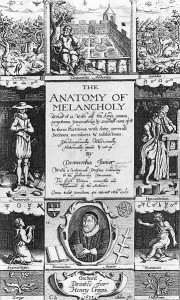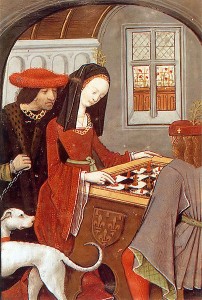During the long English winters, when outdoor pursuits like baiting, cock-fighting, riding and hunting had to be put on hold, the Tudors ventured indoors for some quieter forms of entertainment.
Robert Burton in the Anatomy of Melancholy, published in 1621, lists the following pastimes as suitable winter entertainment: ‘cardes, tables and dice, shovelboard, chesse-play, musicke, masks, singing, dancing, ulegames, frolicks, jests, riddles, catches, purposes, questions and commands, merry tales…’ (Sim, A. pg. 190).
In the very interesting and informative ‘Pleasures & Pastimes in Tudor England’, Alison Sim gives a brief description of some of these popular activities.
Cards
Cards were a very popular form of pastime in Tudor England. Although from where they actually originated is a debatable topic.
Sim believes that they probably developed in China and came to Europe via Egypt, ‘as a Mameluke pack discovered in Istanbul, which dates from about the year 400 AD, looks very like the early Italian packs’ (pg. 191).
In 1371, cards are being referred to in Spain and then described in detail in Switzerland in 1377. By the 1400’s they are being massed produced in Germany and Switzerland and very popular on continental Europe, even so, Sim claims that ‘nobody really knows how they reached England.’ (pg. 191)
But reach England they did and one of the first references to ‘card-playing’ is made in a letter from John Paston to his wife Margaret c. 1459.
She had enquired as to what entertainments a recently widowed neighbour could enjoy over Christmas to which he responded that “although ‘lowde dysports’ such as dancing would not be allowed, chess, tables and cards would be permitted.” (Sim, pg. 192).
An act of parliament passed by Edward IV’s first parliament between November 1461-May 1462 forbade dicing or card-playing in private houses other than during the twelve days of Christmas.
Board games
Apart from card games, board games were a common pastime in Tudor England.
‘Tables’ is known today as Backgammon and in Tudor times it was very popular. A board was found onboard the wreck of the Mary Rose, as were dice.
Not all board games were played on boards. At times, the markings were simply scratched on a convenient surface like the ground.
‘A merrils board and another crude backgammon board were found carved into a barrel lid on the Mary Rose’ (pg. 191).
But it was not only sailors that pursued such pastimes, a merril board can be found scratched in the cloisters of Westminster Abbey.
Other popular games included Chess and draughts (the French name is ‘dames’); Fox and Geese or Fox and Hounds, a game that is known by a variety of names and still played today where one player is the fox and tries to eat the geese or, in another version, one player is the fox and tries to evade the hounds.
According to Sim, a fox and geese board is carved into a stone seat at Gloucester Cathedral, ‘suggesting it was being played in the fifteenth century’ (pg. 191).
Edward IV must have enjoyed playing Fox and Hounds in his spare time, as the royal household accounts include payments for ‘two foxis and 26 hounds of silver overgilt’ (pg. 191) that Sim states would have formed two sets.
Balliards (or Billiards)
This is not our modern day snooker. It is an old game that Louis XI played in the fifteenth century involving a billiard table, sticks and balls. Mary Queen of Scots was obviously a fan of this game, as she complained, a month before she was executed, that her table had been taken away (Sim, pg. 190). In 1588, the Duke of Norfolk owned ‘a billyard bord covered with a green cloth…three billyard sticks and eleven balls of yvery.’(pg 190)
Clash or Pins
The Tudors also played a type of ten-pin bowling where skittles were knocked down with a ball.
Clearly the Tudors found ways of occupying themselves indoors and in the next instalment, I will take a look at what outdoor games were played in Tudor England including tennis, that King Henry VIII loved, and a form of football.
References
Sim, A. Pleasures and Pastimes in Tudor England, 1999.

















Hello
I was just wondering if you had the rules for tables? I do C17 re-enactment and this winters making things project is centred around games . I have drawn the tables/backgammon option and am currently making a set
Thanks
Roly
Hi Roly, unfortunately, I don’t have the rules for ‘Tables’. May I suggest you contact historian Alison Sim who published a book about pastimes in Tudor England, as she may be able to help you. Here is the link to her website: http://www.alisonsim.com/about.html. Hope this helps. Natalie
Any suggestions for indoor Tudor games for children, as Tudor House, Weymouth, Dorset are opening their season with a children’s day, any input would be useful
Thanks
Dorothy